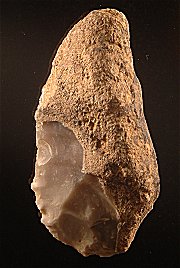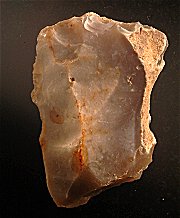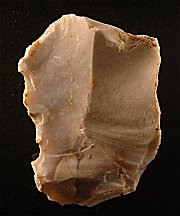| More
about working flint
Stone age toolmakers were occasionally opportunist in adapting a
flint that was unusual in shape. They sometimes even found and
re-used flint tools from earlier periods.
In the main, though, they stuck
to making established design patterns such as the side scraper or end
scraper and hence these are the types most commonly found. If a flint
find conforms closely to a well-known design, that is a useful
positive indication that it is an artefact and not a geofact (a
flint formed by natural processes such as frost shattering) and
may also help in dating it. Some common Mesolithic types are
illustrated right (see also the Tools
Galleries for further examples)
An experienced flint maker will first remove the cortex from a
nodule to expose the flint beneath. These 'primary flakes'
are usually quite thick, have cortex prominently on one side and
are usually discarded. However, occasionally primary flakes
are retouched for use as scrapers. It is very common to find
discarded primary flakes, usually of a protruding nodule that has
been knocked off to trim up the core.
The secondary flakes will also often have remnants of cortex
adhering to one or both sides - often left to provide
a grip when the flake is retouched as, say, a scraper.
Once the toolmaker gets down to good quality interior flint
with no cortex, he or she will carefully prepare a platform on top
and start to remove good quality flakes and blades for retouching.
(A blade is a flint that is more than twice as long as it is
wide).
In the hands of a skilful toolmaker, flakes and blades tend to
break away from the core in a fairly predictable and controllable
way, hence side scrapers and end scrapers of the same general type
are commonly found again and again.
It is also common to find flakes with notches, or concave
depressions, which may have been used as spokeshaves to plane
arrow and spear shafts and perhaps other material such as antler
or bone.
It's not unusual to find wide variation in workmanship.
One site may contain many large, thick roughly made tools.
Another may yield beautifully crafted thin blades, sometimes
exquisitely retouched with superb skill and delicacy. This
may, perhaps, reflect either variation in the skill of the makers,
or the amount of time and resources they had available to make
tools while hunting.
|

A primary flake (with much cortex left) retouched for use as an
end scraper

A commonly found type of side scraper made from a secondary
flake with a small amount of cortex left on one side, possibly as
a grip.

A typical side scraper made from an inside flake with no cortex
left
|